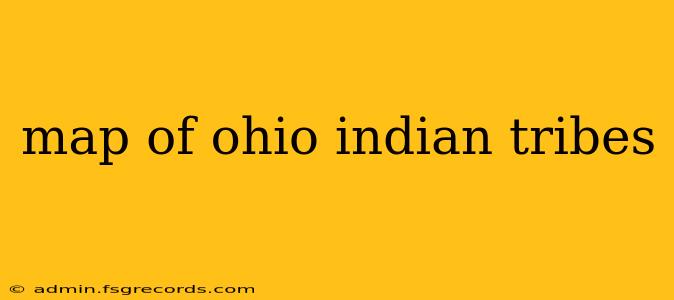Ohio's rich history is deeply intertwined with its Indigenous peoples. Understanding this history requires acknowledging the diverse nations that have called, and continue to call, Ohio home. While a simple map can visually represent the approximate locations of these tribes, it's crucial to remember that these are not static boundaries and that the complex history of displacement and resettlement significantly impacted their territories. This post aims to provide context and understanding beyond a simple map visualization. You won't find a single, definitive "map of Ohio Indian tribes" because the historical record is complex and evolving.
The Complexity of Mapping Indigenous Territories
Creating a comprehensive map depicting the territories of Ohio's Indigenous nations is a challenging task. The pre-colonial landscape was not defined by rigid borders in the same way as modern nation-states. Tribal territories were fluid, often overlapping, and subject to change based on seasonal migrations, alliances, and conflicts. European arrival and subsequent colonization drastically altered these territories, resulting in forced removals and the establishment of reservations.
Further complicating matters is the fact that historical records, primarily from European perspectives, often lack nuance and accuracy in portraying Indigenous land use and governance. Oral histories and traditional knowledge play a vital role in reconstructing a more complete picture but require careful consideration and respect.
Key Indigenous Nations Historically Associated with Ohio
Several Indigenous nations have significant historical ties to Ohio. This list is not exhaustive and represents a simplified overview:
-
The Shawnee: One of the most prominent tribes, the Shawnee were a large and influential nation with a wide-ranging territory that encompassed much of what is now Ohio. Their history is marked by both cooperation and conflict with European settlers.
-
The Erie: The Erie were a significant group inhabiting the shores of Lake Erie before their near-total destruction by the Iroquois Confederacy in the late 17th century. Their historical territory is a key area to understand Ohio's early Indigenous history.
-
The Wyandot (Huron): The Wyandot, also known as the Huron, had a strong presence in northern Ohio. Like the Erie, they faced significant displacement and loss due to conflict and disease.
-
The Miami: The Miami nation held considerable territory in western and central Ohio. Their history is intertwined with the broader political landscape of the Great Lakes region.
-
The Delaware (Lenape): While a significant portion of the Lenape's territory lay outside Ohio, they maintained a presence within the state and played a part in its complex history.
Beyond the Map: Understanding the Present
It is critical to recognize that many of the Indigenous nations mentioned above still exist today. They are not relics of the past, but vibrant communities continuing to uphold their cultures, languages, and traditions. Understanding their contemporary presence is essential to appreciating Ohio's complete history. Seeking out information from tribal websites and engaging with their communities directly is a vital step in learning more.
Finding Further Information
To gain a deeper understanding of the Indigenous peoples of Ohio, explore resources from reputable sources:
- Tribal websites: Individual tribal websites offer the most accurate and respectful information about their history, culture, and current status.
- State historical societies: Ohio's historical society and similar organizations often contain archives and resources pertaining to Indigenous history.
- Academic institutions: Universities with strong Native American studies programs can offer scholarly research and perspectives.
This discussion avoids providing a single map image because accurate representation requires acknowledging the inherent complexities and avoids perpetuating potentially inaccurate or misleading depictions. The focus should remain on acknowledging the ongoing presence and contributions of Ohio's Indigenous nations and their rich history.

